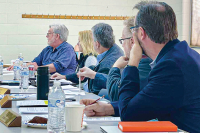Photography stands out among a mixed bag of interest
Putting all of Ed Kelley’s interests in separate, tidy little boxes just doesn’t work.
There’s no way to separate Ed from Ed’s photography; or Ed’s photography from nature; or nature from Ed’s philosophy. There is also Ed Kelley the artist, the musician, the businessman, the husband, the father and the hiker.
When you approach one you get them all – not wrapped into a neat, tidy package but more like a large balloon half-filled with water, and as soon as you feel like you have your hands around the “real” Ed, the water shifts and Ed flows effortlessly, knowledgably and comfortably into another aspect of the balloon.
According to Kelley, he was a teenager before he began to discover the natural world that surrounded him in Haywood County and across Western North Carolina.
“I was 15 or 16 when I hiked to the top of Mt. Pisgah with a friend who was in the Boy Scouts. I was blown away by the view. All the years I had lived here and I had never seen this,” said Kelley, who owns Ridge Runner Naturals Gallery/Studio on Main Street in downtown Waynesville with his wife, Jo, a painter. The studio/gallery is adorned with Jo’s and Ed’s original artwork, including many examples of Ed’s nature photography.
Kelley said not long after that experience he got his drivers license and more and more trailheads in the area became accessible. But, he said a major shift occurred when he was a music major at Mars Hill College.
Related Items
“They had what were called ‘mini-mesters’,” Kelley said. According to Kelley, a mini-mester was about a month-long class between the traditional fall and spring semesters.
“They had a backpacking class, and I signed up,” he said. “It was the first time I had ever been in Shining Rock Wilderness. We had to bushwhack from (U.S.) 276 up to Shining Rock. Then we hiked over to Sam’s Knob and back. We were out there for a couple of nights and it was awesome.”
Not long after that trip, Kelley nixed the music program at Mars Hill and enrolled in Forestry at Haywood Community College. That just served to cement his connection to the out-of-doors.
“We were in the field all the time,” Kelley said. “We had class in the woods; we would cruise timber or learn tree identification and there, I met a good friend who had the same kind of drive for the outdoors that I did.
“We both wanted to learn and see more and more. We went on lots of bushwhacking trips together. We would just get the maps out and say – look we can go from here to here – and we would set out.”
Kelley said there is a good reason his business was named the “Ridge Runner.”
“When we would get the maps out we would look at the ridges. The ridges are the connectors. We didn’t know if there would be trails or not but we knew we could follow the ridges.”
Second nature
Kelley said his attraction to photography predated his hiking addiction.
“I remember being in Washington, D.C., when I was in the seventh grade. I had this little box camera and I went all over town taking pictures,” he said.
“Not long after that I bought an old Canon FX from a photographer friend of the family. It was completely manual. I had a 50mm, a 125mm and a 28mm wide-angle lens and I took that camera with me everywhere. If I was hiking it was in my backpack,” Kelley said.
Looking back, Kelley said he is glad that he learned about photography from his old manual Cannon.
“I learned about light and aperture and shutter speed because all of that had to be done manually. It’s ingrained in me now, and when I go out I can concentrate on the composition of the photograph,” he said.
“Sometimes, now, I will hike to a specific spot at a specific time just to get one certain photograph. I’ve been there before and I’ve seen the scene and I know what time to be there for the best light,” Kelley said.
“Of course there are other times when I just grab my camera and head out to see what I might find.”
Asked to rank light, equipment, subject matter and composition or eye in some sort of photography hierarchy, Kelley said he felt the number one consideration was lighting.
“Everything else being equal, lighting will make or break a photograph,” Kelley said. “The best subject in poor lighting will result in a poor photograph, where a somewhat mundane subject in perfect lighting can produce an exceptional photo.”
Kelley ranked composition — being able to see in your mind’s eye what the finished photo will be, second. He ranked subject third and equipment fourth.
“There is so much decent photographic equipment out there today, that if you learn about light and shutter speed and aperture, and composition you’ll be able to get good photos.”
His favorite times of day to shoot are dawn and dusk.
“The light is just so much warmer then – it kind of embraces the subject instead of just lighting it.”
His favorite season is winter. ‘Because of the lower angle of the sun, you get that warm light for a longer period of time.”
A perfect storm
Kelley thinks the woods and mountains and balds are great. And he believes people can’t help but benefit spiritually and physically by spending time out doors. And for him, adding photography to his walks in the woods just increases his enjoyment. It nurtures his artistic spirit as well as his physical and mental wellbeing.
“I need that balance in my life,” Kelley said.
To see what that balance looks like go to www.edkelley.com.









